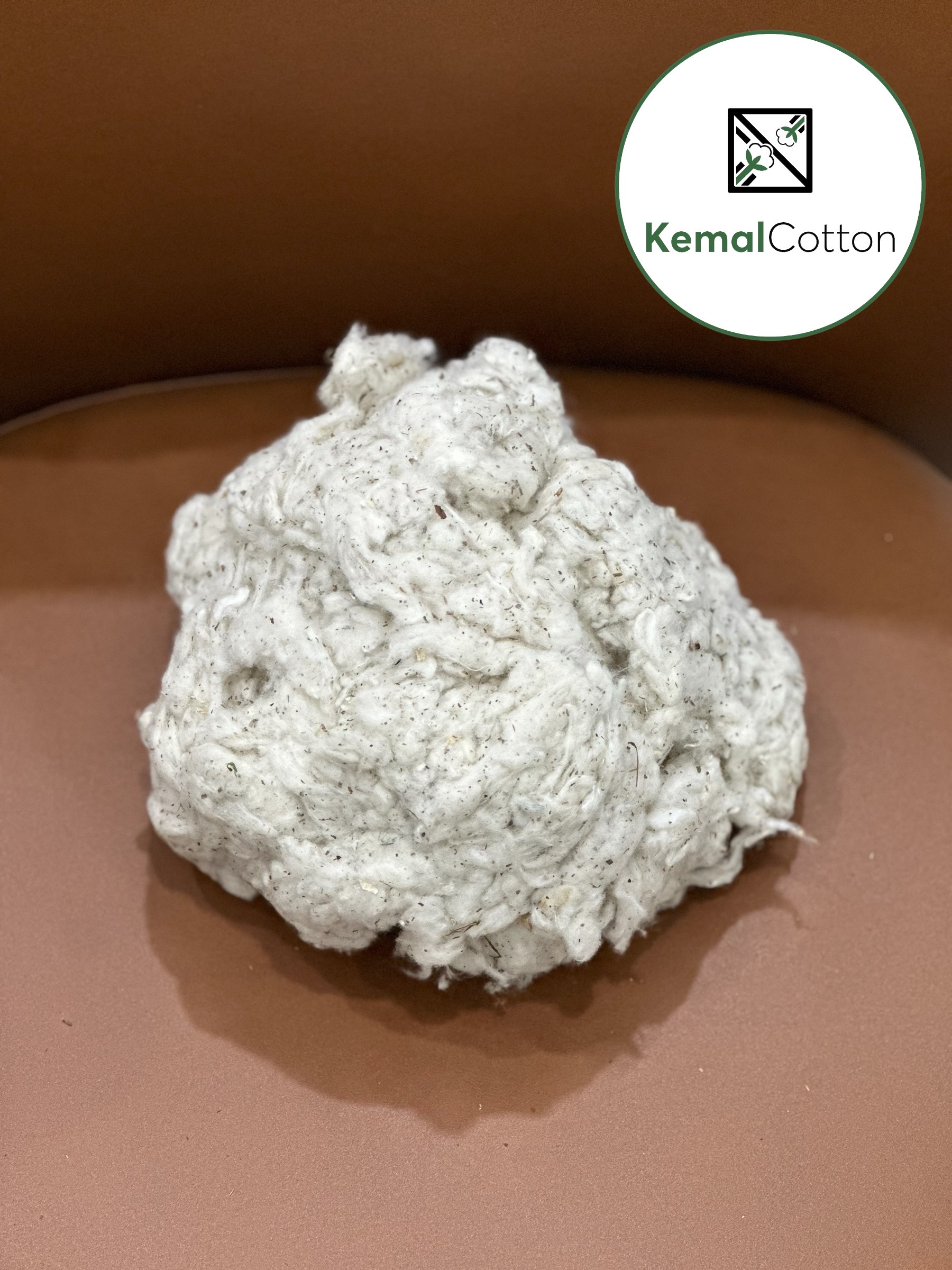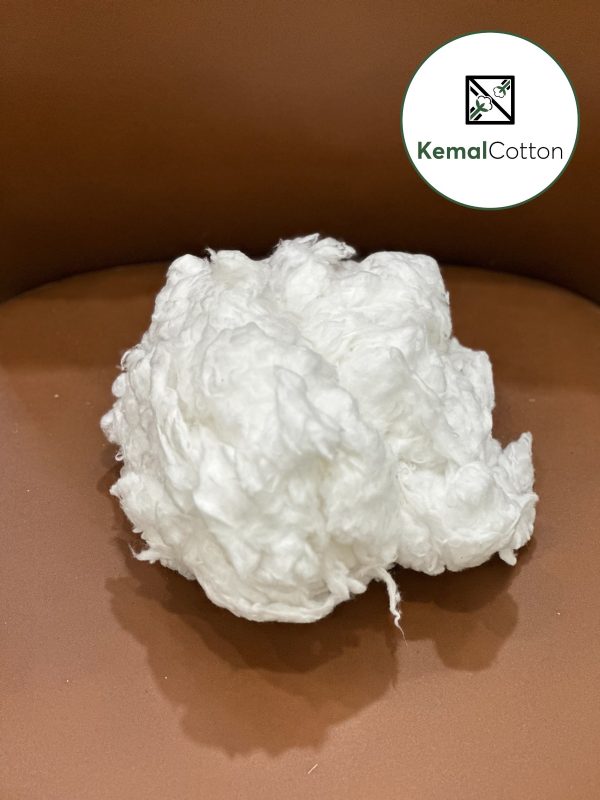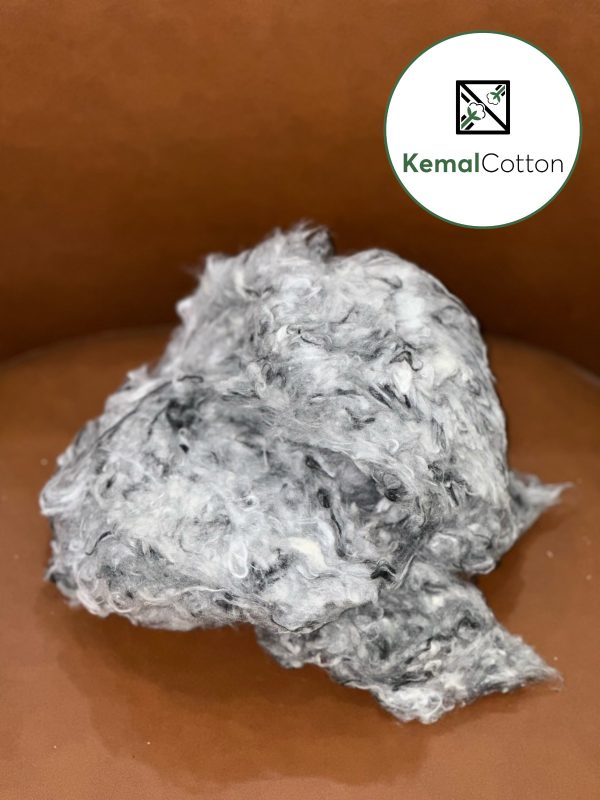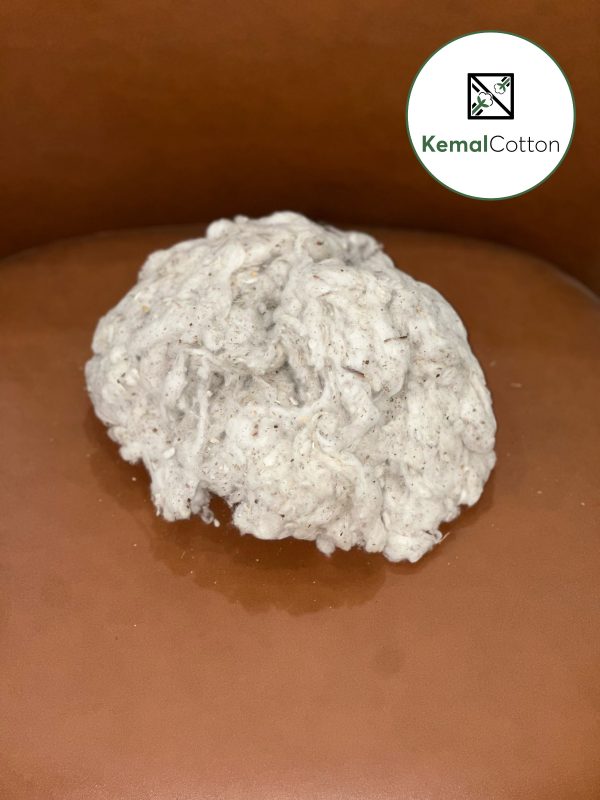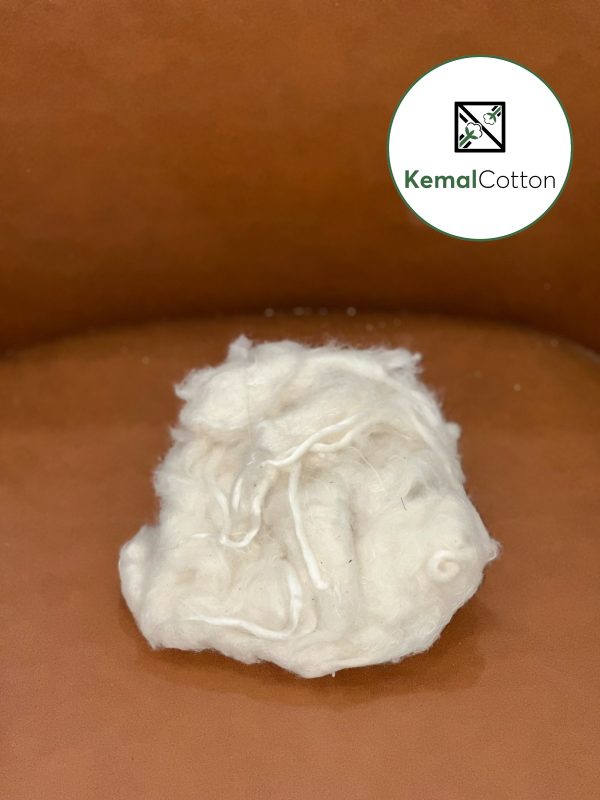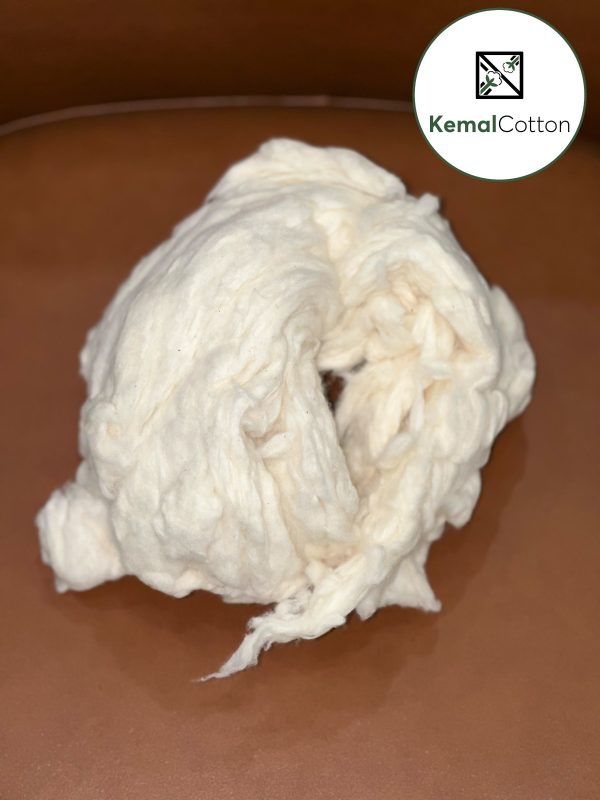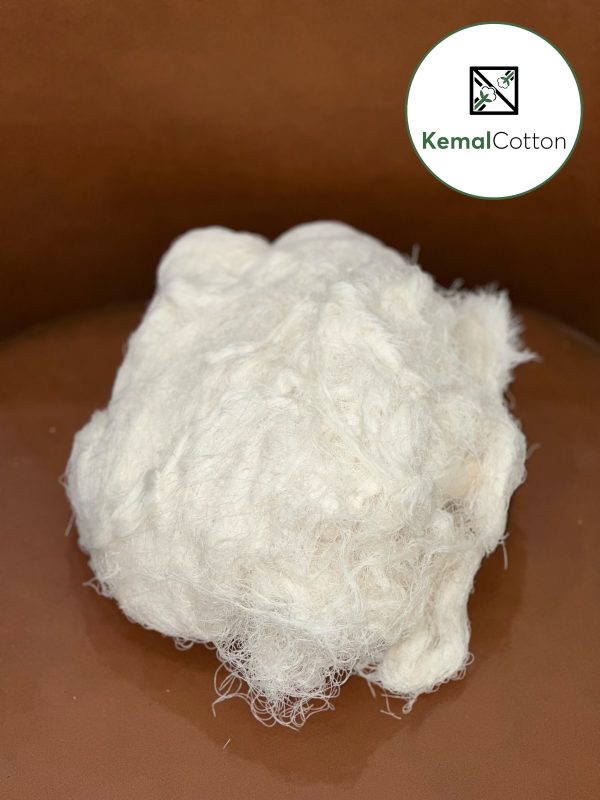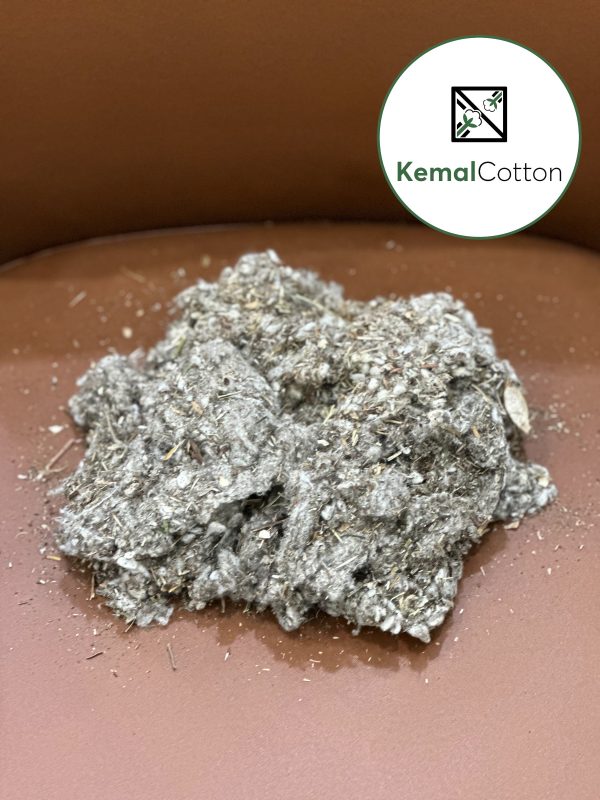Comb Waste (Hat)
under carding waste is a cotton waste generated during yarn production in spinning mills, especially during the carding process. The carding process is an important stage in which the cotton fibres are separated from each other, cleaned and given a uniform structure. In this process, short, fine or foreign fibres are separated and accumulate at the bottom of the card. This waste material is called "under card waste".
Although it cannot be used directly in the production of high quality yarn, it has a recyclable structure. In the textile industry, it can be utilised as raw material in the production of low quality yarns. It can also be used as filling material, insulation products and cleaning cloths. It is frequently preferred as filling material especially in furniture and mattress industry.
Re-evaluation of wastes both supports environmental sustainability and provides cost advantage in production processes. Since the recycling-oriented production approach is gaining more and more importance in the textile industry, the effective utilisation of wastes such as under card waste also contributes to the protection of natural resources.
As a recycling product in line with the sustainable production approach, under-comb waste is an important raw material to reduce costs and minimise environmental impacts. Efficient utilisation of textile waste offers long-term benefits for both the industry and the environment.
Other Products
Bleached Hydrophilic Cotton
Bleached hydrophilic cotton is a type of cotton that has been bleached and purified by special processes to have a high absorbency capacity. By bleaching the cotton, both a brighter whiteness is obtained and its hydrophilic (water absorption) feature is strengthened, enabling it to absorb the liquid quickly. Thanks to these features, it is a product that can be used safely in many different sectors.
In the health and medical field, bleached hydrophilic cotton, which stands out with its hygienic properties, is widely preferred in wound care, bandages, make-up removal pads and baby care products. Thanks to its antiallergic and soft structure, it can be used safely even on sensitive skin. It does not cause irritation when in direct contact with the skin, so it is an indispensable component in the medical and cosmetic field.
This type of cotton, which has an important usage area in the textile sector, is preferred in the production of towels, bathrobes and similar products that require absorbency. It can also be used as a carrier material in the pharmaceutical and chemical industry. Its high fibre structure offers a long-lasting and durable use, while its natural and pure content makes it an environmentally friendly alternative.
Bleached hydrophilic cotton is a basic raw material that provides quality and reliability in many sectors such as health, cosmetics and textiles with its hygienic, absorbent and pure structure. This type of cotton, which is produced without harming the environment with its natural structure, offers a superior experience to its users with its soft texture and high absorbency.
Grey Melange Waste
Grey Melange fluff is a high quality material consisting of a blend of recycled cotton and natural fibres, widely used in the textile industry. This special type of interlining is preferred in many textile products in terms of aesthetics and functionality thanks to its grey melange colour. This material, obtained by blending recycled yarns and natural cotton fibres, offers both an environmentally friendly and economical alternative.
Grey mélange waste, which is obtained by recycling cotton wastes generated in textile production processes, makes an important contribution to the understanding of sustainable production. Since it contains recycled cotton, it both reduces the use of natural resources and provides economic advantages by reducing production costs. In this respect, it is an ideal choice for companies that adopt environmentally friendly production models.
Grey Melange fluff stands out with its soft texture, durability and high absorbency capacity. Thanks to these properties, it has a wide range of uses in the fields of towels, blankets, upholstery fabrics, yarn production and industrial textiles. The naturalness and homogeneous structure of the colour tone increases the aesthetic appearance and quality of the final textile products and extends their service life.
Grey melange waste, which contributes to both nature and economy thanks to its recycled cotton content, is an innovative and functional raw material that supports sustainability in the textile industry. This product, which combines quality and environmentally friendly production, continues to be one of the indispensable components of the modern textile world.
Pulp Mill Waste
Blowroom waste is a type of cotton waste generated during the blowrooming (opening) process in spinning mills. The blowroom process is a critical step in the processing of raw cotton by opening, fluffing and separating the fibres so that they are ready for further processing. In this process, short, fine and irregular cotton fibres and foreign materials are separated and these residual materials are called blowroom waste.
Although it cannot be used directly for high quality yarn production, it is an economical and environmentally friendly product that can be utilised in many different areas. Thanks to its recyclable structure, it can be used as raw material in areas such as low quality yarn production, filling material, insulation products and industrial cleaning cloths.
It is widely used in the furniture and mattress industry, especially as a filling material, and offers an effective alternative in insulation products. Supporting sustainability in the textile industry, pulp waste contributes to improving waste management and offers cost advantages in production processes.
Re-evaluation of textile wastes is of great importance in terms of both reducing environmental impacts and providing economic benefits. By enabling the recovery of cotton waste, pulp helps to use natural resources more efficiently and supports the sustainable production approach.
Square Compensation
Square waste is a recycling product obtained by recycling wastes such as fibre and yarn generated in cotton processing processes. Some fibre loss occurs at every stage of cotton production, especially in the combing, cleaning and spinning processes. In order to prevent these losses from being wasted and to support sustainable production, the square waste is reintroduced into the blend and made reusable.
In cotton processing factories, it is of great importance to utilise the fibre in the most efficient way. Thanks to its cotton fibre content, square waste can be used as raw material especially in yarn production. This recycling material can be utilised in the production of new yarn or in the production of woven and nonwoven fabrics after certain processes. In this way, both the protection of natural resources is contributed and economic efficiency is increased by reducing production costs.
In addition, square waste is an important source of raw material for the recycling sector. With sustainability becoming increasingly important in the textile industry, the efficient utilisation of such by-products improves waste management by reducing environmental impacts.
Square waste is an important element that increases reusability by maintaining quality in the production of cotton products. It offers economic and ecological advantages for both manufacturers and companies that adopt environmentally friendly production.
Combed Interlining
Comber waste is a textile by-product resulting from the combing process during cotton yarn production in spinning mills. The combing process separates the long and high quality cotton fibres to produce more even and durable yarns. In this process, short, irregular and lower quality fibres are separated and accumulated and this material is called "combing waste".
Although combed waste cannot be used directly for the production of high quality yarn, it is utilised as a valuable raw material in various industrial and textile fields. In addition to being used in the production of low-quality yarn, it is also used in different sectors such as filling material, insulation material and industrial cleaning cloths.
Combed cotton waste, which is used as filling material especially in the furniture and mattress industry, can also contribute to the production of insulation materials. In addition, it is preferred in the production of industrial type cloths thanks to its high absorbency in the cleaning sector.
While sustainability and recycling are gaining more and more importance in the textile industry, the re-evaluation of by-products such as combing waste provides both cost advantages and contributes to environmental waste management. The recovery of such waste offers economic and ecological benefits by supporting more efficient use of natural resources.
Top Tube Compensation
The overcasting waste is a type of textile waste generated during the cleaning and maintenance of the machines during the production processes in spinning mills. The yarn fragments, cotton fibres and dust residues accumulated on the machine surfaces are referred to as the trash. Although this residual material cannot be used directly in the production of high quality yarn, it can be recycled in many different areas.
Toppings, which has a widespread use as a cleaning cloth in the industrial sector, is an effective solution especially for cleaning machines thanks to its durable and absorbent structure. It is an ideal material for cleaning oil, dust and other dirt in factory environments and is also used for cleaning purposes in different sectors. It can also be preferred as filling material in furniture, upholstery and packaging sectors.
The overcasting waste can be used as raw material in the production of low quality yarns and thus contributes to waste management. While the sustainable production approach is gaining more and more importance in the textile industry, the utilisation of such wastes both reduces environmental impacts and offers economic advantages.
With its structure suitable for recycling processes, toppings waste is an environmentally friendly material that helps to reduce textile waste. This type of waste, which is used in different fields such as industry, cleaning and filling material production, contributes to the efficient use of waste in production processes.
Manger Waste
Feed waste is a natural by-product of cotton processing and is used as a feed additive, especially in the livestock sector. This waste, which is produced during the cleaning and processing of cotton fibres, has become an ideal component in animal feed production thanks to its fibrous structure.
High fibre content in animal nutrition supports the digestive system to work more efficiently. Thanks to the natural fibres it contains, fodder waste provides a healthy nutrition process by contributing to the digestive system of cattle and sheep. At the same time, it contains a rich content in terms of energy and nutritional values.
Due to its natural structure, it does not contain chemical additives and is preferred as an environmentally friendly and economical feed additive. It is widely used as a source of fibre in the feed industry, especially in the feeding of ruminant animals. Since it has a high fibre content, it facilitates digestion and enables animals to benefit better from nutrients.
This by-product increases the sustainability of cotton farming and creates economic value by preventing waste. Feed waste helps to provide efficient and natural nutrition while reducing costs in animal husbandry. This product, which is an important component for farmers and feed producers, attracts attention with its positive effects on animal health.
